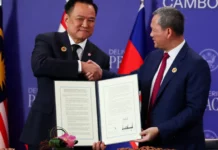 BEIJING: India and China have made history during the just concluded visit of Prime Minister Manmohan Singh by working on a new set of rules for the smooth development of bilateral ties and reshaping the world, the Chinese media said today.
BEIJING: India and China have made history during the just concluded visit of Prime Minister Manmohan Singh by working on a new set of rules for the smooth development of bilateral ties and reshaping the world, the Chinese media said today.
“History can be made in a moment, especially when two of the world’s most populated nations are determined to do so,” a commentary by the state-run Xinhua news agency said.
“As Chinese Premier Li Keqiang and Indian Prime Minister Manmohan Singh shook hands in Beijing and cheered exchange of visits, the two Asian giants have come to a common view of facing up to the future, rather than looking back,” it said summing up the official mood here about the outcome of Singh’s three-day visit which concluded yesterday.
As two emerging economies with over one-third of the world’s population, “China and India are working on a new set of rules that will not only lay a smooth track for bilateral ties, but also help reshape the world,” it said.
Nine agreements including the Border Defense Cooperation Agreement (BDCA), besides a new MoU on trans-border Rivers were signed during Singh’s visit.
“In a bid to build greater trust and confidence, China and India signed BDCA. Both sides hailed the agreement as a powerful tool to maintain peace and tranquility on the border, a ‘foundation’ for the growth of China-India relationship,” the commentary said.
Singh held talks with both President Xi Jinping and Premier Li on all most all aspects of Sino-Indian relations.
His three day tour received wide attention in official print and television media.
Singh in his speech at Chinese Communist Party Central School where top leaders gets trained also enunciated a broad outline for future relations between the two countries to maintain close ties while addressing their mutual concerns.
Both Premiers hold a clear vision about where the biggest potential of China-India relations lies and are committed to realizing the global prominence of the strategic partnership, the Xinhua commentary said. “China-India relations have gone far beyond bilateral scope and have global and strategic significance,” Xi said during his meeting with Singh, who responded by saying “when India and China shake hands, the world notices,” Xinhua said.
The two sides vowed to strengthen coordination and cooperation in multilateral forums including China-Russia- India, the BRICS and G20.
“In move that may change the geo-political map in Asia and the world, China and India decided to move ahead with preparation for the BCIM Economic Corridor that compasses Bangladesh, China, India and Myanmar. China expressed readiness to step up investment, railway construction and industrial zone development in the region,” it said.
The flow of funds, goods and people through the maritime Silk Road across the sub-continent will be identical to what happened in history, a precedent from which the two ancient countries draw wealth and strength for current cooperation, it said.
To enhance friendship and understanding between the two peoples, China and India agreed to launch a series of joint events, including a Year of Friendly Exchanges, sister-city relationships and commemoration of the 60th anniversary of the Panchsheel, it said.
“The seed of friendship sown today will bear fruit in coming generations. Such long-term initiatives demonstrate the vision and wisdom that the two ancient cultures share in building their future in a changing world,” it said.
“The all-round improvement in political trust, practical cooperation and people-to-people contact cast light on the prospect of China-India relations – The two most dynamic economies in the world roll ahead side by side at a more coordinated pace and in constructive competition. And a peaceful, cooperative China-India relationship is bliss for Asian resurgence and global prosperity and stability,” it said.
“And they do have the potential for success. In 1954, the prime ministers of China and India issued a joint declaration to officially designate the Five Principles of Peaceful Coexistence (Panchsheel) as guidelines for bilateral relations. These principles have been widely recognized as norms of international relations over the past six decades,” the commentary added.–PTI






